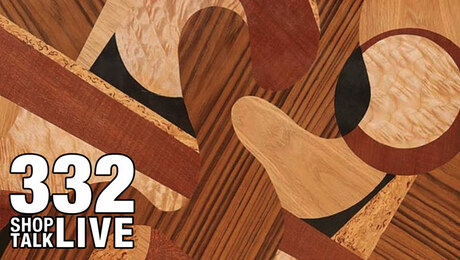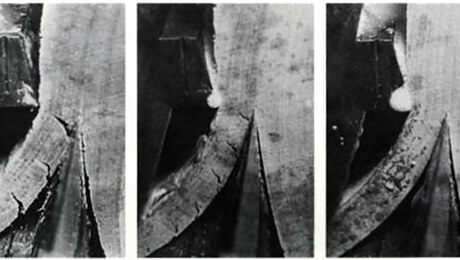Get Started in Marquetry
Chelsea Van Voorhis's fun, versatile way to incorporate marquetry into your next projectI started working with veneer in 2017 because I didn’t have consistent access to a woodshop, and I could easily cut veneer in my home without producing sawdust. I soon found I was able to create a marquetry panel with just a little bit of practice. I needed only a small amount of tooling to get started and had the ability to work nearly anywhere. As time has passed and my passion has grown, I’ve invested more money to buy nicer tools. But before spending hundreds of dollars on tools and materials, you can experiment with veneer in affordable ways.

Making an abstract pattern like the one I demonstrate in this article will allow you to experiment with color, scale, contrast, and composition, while learning how to cut and assemble marquetry packs.
Cutting your first pieces
I begin an abstract piece by selecting the veneer. I purchase sample packs from Certainly Wood; I like knowing that the company sources its material responsibly. For this piece I chose teak, fiddleback makore, crotch maple, burl maple, chestnut, and dyed gum, keeping in mind the range of colors and the mix of straight and figured grain.
 |
 |
I selected teak as my predominant species. Because the teak parts would be the largest, dictating the pattern and flow of the entire piece, I cut them to shape first. I use an Olfa 9mm SVR-2 utility knife with a snap-off blade to cut my veneer. (You can find similar knives at a hardware store for less.) It is important to take multiple light passes when cutting the veneer. The initial cut is a very light score line. If you use too much pressure or swipe too quickly, you will not achieve a clean or straight line. When cutting along the grain, the knife can travel in the grain rather than along the intended line. Using light strokes and multiple passes over the same line is especially important here. Keeping the knife perpendicular to the wood is important as well. This ensures that the edges will be square to the face and the seams will come together cleanly. A metal ruler is also useful for cutting straight lines.

Curved cuts can be made with scissors or a knife. When using either, make sure to keep the tool perpendicular to the wood or the veneer will break apart. I cut my pieces on a cutting mat, but you can also use a fresh piece of plywood as a backing board beneath the veneer.
Assembling the pattern

Visualize the image. Allow yourself time to arrange the pieces in a way that is pleasing to the eye. Laying an already cut shape over an uncut sheet allows you to assess many possibilities. Once you’ve found the best placement, tape the two pieces together.

Cut and tape in place. Using the piece you’ve already cut as a guide, cut along the edge, creating a clean seam. As you near a piece of tape, lift it, continue cutting, and restick the tape. After finishing the cut, flip the assembly and stretch tape across the seam, allowing the stretchiness of the tape to close it.
After I have cut the largest pieces to shape, I start to add medium-size components. I use pieces with larger grain patterns for the bigger areas because it displays their beauty. I wait to add smaller pieces of veneer with tighter grain. I am also mindful of grain direction when laying out a panel. Placing two pieces next to each other with alternating grain gives the panel contrast and chatoyance.

Make the next cut. Working from the front again, go on to the next cut. As ever, be sure to hold your knife perpendicular to the veneer. Since I don’t plan out an abstract design ahead of time, I experiment with the layout at this stage. I take the largest pieces, which I’ve already cut to shape, and lay them on top of medium-size pieces. Some layouts will come together quickly, while others will take time before I think they are balanced and beautiful. Once I find a layout that I like, I attach the pieces with blue tape, then start cutting.


Build the pattern as you go. With the first two pieces joined, you can add a third. Tape in multiple places to help hold veneer for accurate cutting.
Lay a shaped piece on top of a piece that you want next to it, and use a few strips of tape to secure them. Slowly cut around the top piece, using its edge as a guide for the knife. When you get to a piece of tape, lift it, cut under it, and then press it back down, making sure the veneers don’t shift. When in doubt, use more tape.

Once the cut is finished, leave the tape on the front and flip the veneers over; set the waste piece aside. To fully close the seam, press tape on one side and then pull and stretch the tape over the seam. Stretching the tape will add tension and pull the seam tight, much like a butterfly bandage. You do not need tape on every inch of the seam, but make sure most of it is covered. Then flip the veneers again and remove the tape from the front.

Reinforce the back. Remember to tape the back of the panel as you work through the process. This tape will be removed later prior to glue-up. Once the large and medium components are assembled, I add smaller pieces. The smaller the piece, the higher the chance of breaking off short grain. To avoid this, I tape the back of the veneer before cutting. If a little piece does break off while cutting, I can easily put another one in its place. Often people are intimidated with how fragile veneer can be, but it is also easy to repair.
 |
 |
Once the panel is completely cut, the front will be exposed and the back will have several layers of overlapping tape. Lay strips of tape over the entire front, butted next to each other but not overlapping. Little gaps are fine, but overlapping tape will cause uneven pressure during glue-up. Once the front is covered you can flip over the assembly and remove all the layers of tape from the back. Be careful not to pull out small fibers. Take a good look at every inch of your project. If you find a large gap, you can cut another piece of veneer to fill it, making sure the grain is going in the same direction.
Gluing to the substrate

Once your design is complete, you are ready for the glue-up. This step can feel stressful because there are things that can go wrong. However, there are a few steps you can take to help ensure that you have a good glue-up.

The even layer of tape over the front of the project prevents pieces from moving around during the glue-up process. I use PVA wood glue because there is water in it, and the moisture will swell the fibers. If there are slight gaps between the seams, the glue can sometimes pull those together. Also remember that if you are using wood with contrast, a small gap in the seam is not going to be obvious, and your eye will travel over it.

Clamps and cauls are essential for a good glue-up. When in doubt, use more clamps than you need. For a small panel, you can use a sheet of plywood alone as a caul; add thick solid-wood cauls for larger panels. A plastic sheet just larger than the panel will prevent it from sticking to the cauls. And a framing mat between the plastic sheet and the cauls will provide even pressure across the panel. When working with commercial veneer, different species can have slightly different thicknesses. Framing mats are thick enough to compress and create even pressure, and they can be found at any frame shop or craft store.
It’s important to balance the project by gluing a sheet of veneer to the back side of your substrate. Having veneer on just one side would allow an uneven amount of air and moisture in and cause the piece to warp.
Always practice a dry glue-up before putting any glue on the panel. Prep all of your materials, and clamp up the panel to make sure everything goes smoothly during the actual process.
With the marquetry pattern, be sure to apply glue to the substrate and not the veneer, because if you spread glue across the veneer seams, there is a chance fibers can be pulled out. Make sure to cover every inch of the substrate with glue. Use a good amount of glue, but not so much that when you hold it upright it drips. I use a veneer scrap to evenly distribute glue over the entire surface. Wrap four or five pieces of tape around the edge of the package so the substrate does not slide when clamped. The bigger the panel, the more cauls and clamps you will need. Leave the piece clamped up for approximately 8 hours.
Carefully sand your panel
After you take the piece out of the clamps, pull off the plastic sheet and then the tape from the front of the panel. Remove the tape slowly and delicately to avoid pulling out any fibers. If you do happen to remove a piece of veneer, dab a small amount of glue, press the piece back in place, and tape it down.

Commercial veneer is thin, so it is important to sand carefully. I start with 120-grit using a sanding block, or a palm sander for larger panels. I sand lightly, only until the excess glue is removed, then work my way through higher grits. I use 120, 220, and then a gray Scotch-Brite pad.

Veneer can vary in thickness and density, and certain species are easier to sand through than others. Know what to look for when sanding. A dark spot could just be a knot that does not need more sanding, but if it is next to a seam, it could also be glue that is not fully sanded yet. If a different color starts to show, that could mean the wood is about to be sanded through. Stop sanding in that area. Take it slow, sand a little bit, and then inspect the veneer.

You will inevitably sand cross-grain as you work, and this will show up in certain species more than others. You can go back over those areas with 220-grit to blend scratches. Remember that nothing is ever going to be perfect, and there are many solutions to changing a panel you don’t like, or starting over with a brand new image. There is always pressure and pride in a beautifully crafted piece, but I love some of my “imperfect” ones just as much, if not more.
Chelsea Van Voorhis is a veneer artist and designer in New Orleans.
| From Fine Woodworking #315
To view the entire article, please click the View PDF button below. |
 |


























Comments
Nice work! I usually draw the shape and then cut through two layers, saving one. I like using the knife but my hands do not, so use a reciprocating saw instead. You have a nice sense of composition, keep it up!
Log in or create an account to post a comment.
Sign up Log in